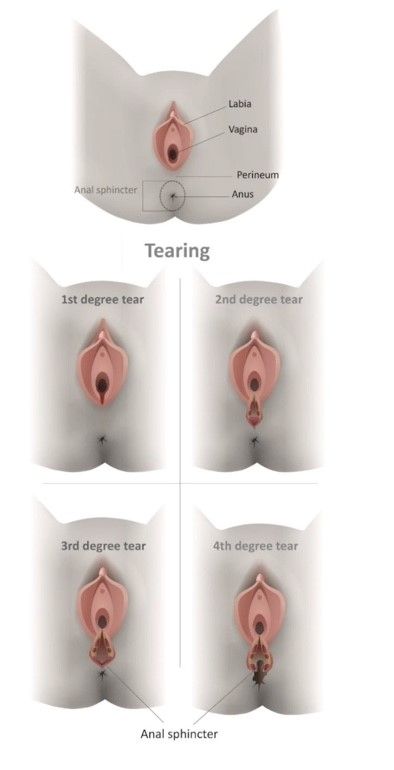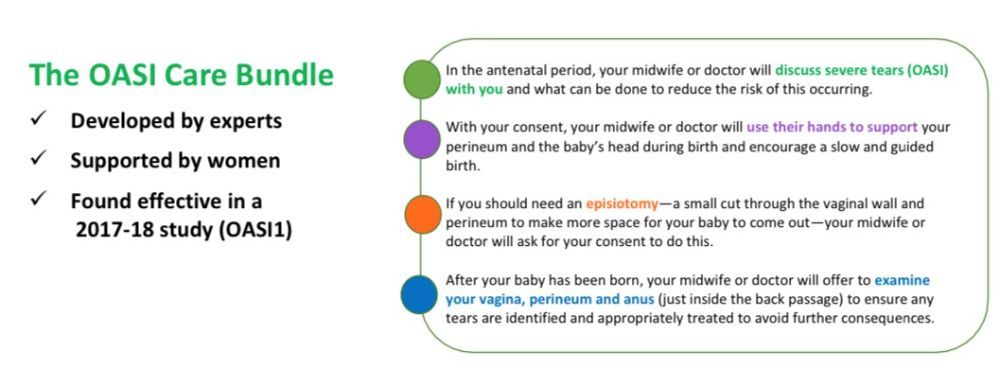Tears during childbirth
 Please click here for an Antenatal discussion guide for Perineal Health in Pregnancy, Birth & Beyond
Please click here for an Antenatal discussion guide for Perineal Health in Pregnancy, Birth & Beyond
What types of tears can occur during childbirth?

Up to 9 in 10 women who give birth vaginally will experience some sort of graze or tear that affects the labia or, more frequently, the perineum, the area between your vagina and anus.
For most women, these tears are minor and heal quickly. After your baby’s birth, the midwife or doctor will ask to examine your vagina, perineum and anus to see if you have any grazes or tears, how deep they are and discuss treatment options.
- 1st degree: tears affecting only the skin, usually heal quickly and without treatment.
- 2nd degree: tears affecting both muscle and skin, usually require stitches.
- 3rd and 4th degree: severe tears which extend to the deeper muscle that controls the anus (the anal sphincter), requiring stitches to heal. These are also called ‘obstetric anal sphincter injuries’ (OASI).
What causes severe tears?
Severe tears (OASI) are not always possible to predict.
You may be at higher risk if:
- Forceps are used during birth.
- This is your first vaginal birth
- Your baby is born in the back to back position
- Your baby is over 4kg (9lbs)
- You are of South Asian ethnicity
- Your baby needs to be born quickly
- Your baby’s shoulder gets stuck behind the pubic bone (shoulder dystocia)
- Ventouse / kiwi cup are used during birth
- Pushing stage of birth takes more than 4 hours

What can be done to reduce the risk of a severe tear?
Perineal massage from 35weeks until birth has been shown to reduce the risk of tears. Ask your midwife about how to do this or visit rcog.org.uk/tears
Please click here for further information from the RGOG.
Women must be able to mobilise freely during labour and delivery, if they choose to do so. Manual Perineal Protection can be carried out in most positions. Please click here for positions in labour
The OASI Care Bundle is a set off our practices that your midwife or doctor can use to support you in protecting your perineum.


A warm compress during the pushing phase of labour is also beneficial in reducing risk of tears. Ask your midwife or doctor if they offer this.
Certain birth positions can further reduce risk of severe tears. Your midwife or doctor will encourage you (where possible) to find a position that feels comfortable to help ensure a safe and positive birth experience.
What are the long term effects of severe tears?
Most women with a diagnosed severe tear (OASI) that is immediately repaired heal completely, but it can take some time. Long term effects for some women may include:
- Difficulty or inability to control their bowels or the passing of wind
- Depression, feelings of anxiety, low mood, isolation
- Anxiety about having to access the toilet often with concerns about leaving the house
- Difficulty bonding with their baby
- Concerns about leakage while exercising
- Concerns about having sex or giving birth again
If you experience any of the above symptoms, especially 6-8 weeks after birth, please contact your doctor or midwife as soon as possible to access specialist care.
Please visit the MASIC website for further information and support: masic.org.uk
This guide was developed for the 29sites participating in the OASI2 Project, taking place Sept 2021-Dec 2022. It is now being made more widely available in response to wide ranging requests. For more information please visit: rcog.org.uk/OASI2




